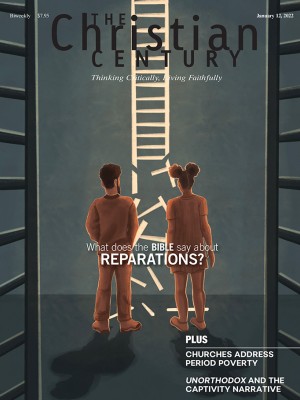Giving and receiving care are what we’re made for
Arthur Kleinman’s memoir gets at the heart of what it means to be human.

Pastoral care, Gregory the Great once wrote, is the art of arts. That evocative phrase is brought to life in The Soul of Care, a recent memoir by anthropologist and physician Arthur Kleinman. Kleinman describes caregiving as grounded in presence that embodies the liveliness and fullness of being and in the willingness to stay turned toward another, even in the midst of pain and confusion. For Kleinman, the soul of care is improvisational and awake to the dimensions of existence that can’t be fully known or described.
Kleinman writes about how, after his wife, Joan, developed early-onset Alzheimer’s disease and began not always to believe him when he told her that he was her beloved husband, he learned to take her hand and kiss it, assuring her that she was loved and that he was who he said he was. When even those loving gestures failed to reassure her, he would improvise and pretend to be someone else, someone who was there simply to help her. Others took their cues from him. Once when Joan wandered out of the family circle in a busy subway station, her five-year-old granddaughter took her hand, kissed it as she had seen her grandfather do, and gently led her back.
Read our latest issue or browse back issues.
Like his granddaughter, Kleinman was lucky in his mentors, who taught him to listen beyond the surface of his interactions for what he calls their “human tone.” A neighbor whose husband had a disability, a boss when he worked in the New York City sewer system—they don’t tolerate any romanticism from him, insisting on the reality of their lives and teaching him to be present to it.
Joan does the same. Kleinman acknowledges that Joan was more fluent than he, not only in languages but in the emotional, spiritual, aesthetic, and moral languages of their family’s life. She built a foundation beneath him that made his life possible. When he has to take charge of their domestic arrangements, Joan is surprised that he can. Joan, Arthur writes, “saved me. . . . She made my life; she made me.” That refashioning is at the heart of their relationship. Through the giving and receiving of care each is made and remade.
Kleinman’s understanding of care challenges us to be remade as well, not only as individuals but as a society. What would happen if we understood the challenges of our time as crises of care? What difference would it make, for example, if we understood the suffering of migrants and asylum seekers as a failure of care? The suffering of others, especially suffering inflicted in our name, makes a claim on us precisely because, as Kleinman argues, the capacity to care is the bedrock of our humanity. We are here to care, he says. The theological insight that permeates this book is that our fragile bodies and our vulnerable lives are signs that we have been placed in each other’s care. Giving and receiving care, Kleinman insists, is what we’re made for.
We may be made for it, but it’s hard. In his narrative of care, Kleinman acknowledges both moments of tedium and moments of profound significance. He describes the terror and panic that can arise when someone is in our care as well as the moments of deep human connection that can re-ground us. He shows us the self-doubt and the hopelessness by which caregivers and care receivers are tormented and also the honesty that is cultivated when they remain turned toward one another.
Kleinman was required to bear witness to unbearable suffering early in his training as a doctor. His job was to sit and hold the hand of a badly burned seven-year-old girl as she was lowered into a whirlpool bath to have her wounds debrided. Kleinman tried to distract her from this torment, to turn her attention in another direction, but she screamed and struggled and begged for help. Finally, he asked her: What is this like for you? And she gathered herself and told him. That little girl taught him what he calls “a clinical truth”: that a relationship of emotional and moral resonance can be built between a doctor and a patient more by focusing on what is actually happening than by turning away from it.
Toward the end of the book, Kleinman describes an ordinary night of caregiving. He and Joan spend the evening together, he helps her get ready for bed, and he lies with her in his arms until she falls asleep. Once she’s settled, he gets up, tidies the house, checks his email. Before he goes to bed, he spends time studying her face. Reading her face is like lectio divina, he writes—like the kind of slow, contemplative, prayerful reading that leads not to certainty about what the passage means but to a sense of the many meanings that might open from it, some of which are inaccessible to us. Watching Joan sleep, Kleinman reverences both what he knows and what he doesn’t. “There is something special here that consoles my spirit,” he writes, “as if I can feel fate working things out for us. But how?”
We all need practices that help us regard one another with compassionate attention—and with hope, however mysterious. We all need environments that support our capacity to ask one another: What is this like for you? The practice of care is powerful enough to offer an alternative story of who we are and what we owe one another. The Soul of Care challenges us to place it at the center of our life together.
A version of this article appears in the print edition under the title “Made for care.”






